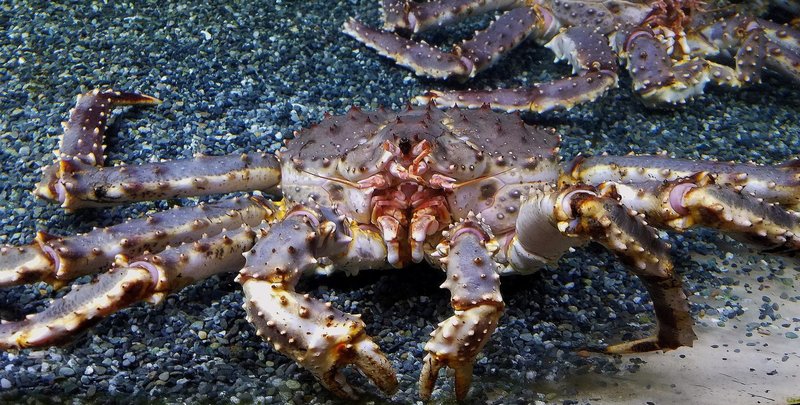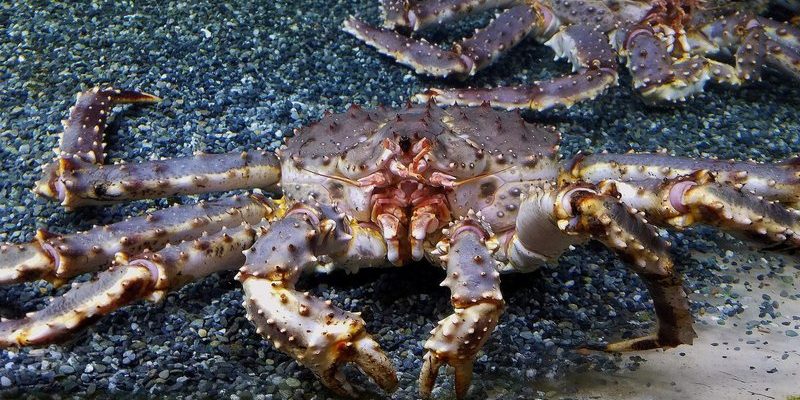
Now, you might be wondering why the king crab deserves a spot in your mind. Well, these creatures are a big deal in the culinary world and play a crucial role in marine ecosystems. They’re like the celebrities of the sea. So, let me explain what makes them so special!
1. Giant of the Sea: The Size Factor
First off, let’s talk about their size. King crabs can grow to extraordinary lengths—some species can even stretch up to 6 feet across! Imagine that for a second: a crab with legs that can encompass a decent-sized dinner table. These crabs can weigh anywhere between 6 to 25 pounds on average, depending on the species. The largest king crab ever recorded weighed in at an astonishing 28 pounds!
Their immense size isn’t just for show, though. Having a larger body allows them to survive in the chilly waters of the northern Pacific Ocean. They thrive in depths between 600 to 1,500 feet, which means they can handle colder temperatures than many other marine creatures. So, while a little crab might fit right in a cozy tide pool, the king crab is built for deep-sea adventures.
2. A Feast for Seafood Lovers
King crabs are not just interesting because of their size; they’re also a delicious catch! They are considered a delicacy in many parts of the world, particularly in Japan, the United States, and Russia. If you’ve ever had a king crab leg, you probably remember how sweet and tender the meat is, with that perfect buttery flavor. Honestly, it’s hard to resist!
The demand for king crab has created a thriving fishing industry, but here’s the catch—pun intended! Due to overfishing concerns, there are strict regulations in place to ensure sustainable harvesting. Fishermen often have to follow specific quotas, and only a limited number of licenses are issued each year. This careful management helps keep populations stable and ensures that these tasty crabs will be around for years to come.
3. Mysterious Molting Process
Another captivating aspect of king crabs is their molting process. Just like a snake sheds its skin, king crabs periodically shed their exoskeletons to grow. This process is called molting, and it’s as dramatic as it sounds. They actually stop eating days before they molt, conserving energy for the big event.
During this time, they can become vulnerable to predators since their new shell is soft and not fully hardened yet. When they finally break free from their old shell, they emerge bright and shiny, ready to grow into their new larger form. Imagine being able to change your size! It’s a fascinating survival strategy that allows them to adjust to their environment and grow as needed.
4. Unique Habitat Preferences
King crabs are picky about where they call home. Most of them prefer cold, deep waters, particularly around the coasts of Alaska and the Bering Sea. They thrive in environments that offer plenty of hiding spots, like rocky terrains and seaweed beds. These habitats provide safety from predators and a place to find food.
Interestingly, king crabs are also known to migrate. They move from deeper waters to shallower ones during the molting season and for spawning. This migration helps them find the right conditions for breeding and growing. It’s like a yearly family reunion in the ocean!
5. Predators and Prey
In the grand underwater food chain, king crabs are not at the top. They have their fair share of predators, including larger fish, seals, and even sea otters. However, in turn, they play a critical role in their environment by feeding on various organisms, like mollusks, sea cucumbers, and smaller invertebrates. It’s a classic give-and-take scenario in the marine world.
Imagine a king crab gracefully scuttling along the ocean floor, munching on a clam here and a sea cucumber there. It’s vital because their feeding habits help keep the ecosystem balanced. By preventing any one species from overwhelming the environment, they ensure a diverse and thriving sea community.
6. Social Creatures with a Twist
You might think of crabs as solitary creatures, but king crabs have a social side too! While they can be territorial, especially during mating season, they often gather in groups to feed. These gatherings can look like a mini crab party, where they share resources and even communicate with each other using their antennae.
Isn’t that neat? They have a complex body language that signals their mood or intentions, which helps them navigate relationships, whether they’re looking for a mate or establishing territory. So, while you might see them as tough little critters, there’s a whole world of social dynamics going on beneath the surface!
7. The Dangers of Overfishing
Speaking of gathering resources, king crabs face serious threats from overfishing. As mentioned earlier, their popularity as seafood has led to increased fishing. But too much harvesting can jeopardize their populations. That’s why many regions have implemented strict regulations and sustainable practices.
For example, many fisheries practice “catch and release” or “limited catch” strategies to ensure they don’t disturb the natural balance. By taking care of these majestic creatures, we help protect not only their populations but also the entire marine ecosystem, which relies on their existence. It’s a community effort in the vast ocean, and sustainability is key.
8. Cultural Significance
King crabs also hold a unique place in various cultures, especially among indigenous people in Alaska and the Pacific Northwest. They’re not just a source of food; they’re a symbol of livelihood and tradition. In some communities, catching king crabs is part of cultural practices, passed down through generations.
You might find festivals celebrating the king crab, honoring its significance in local cuisine and economy. From crab feasts to art showcasing these creatures, they resonate deeply with how coastal communities connect with their environment. It’s incredible how a single species can tie together such rich cultural threads!
9. King Crab vs. Snow Crab: A Comparison
When it comes to crabs, the king crab often gets all the attention. But what about its cousin, the snow crab? While both are delicious, they have some key differences. King crabs are larger and meatier, with a more distinct flavor and texture. Snow crabs, on the other hand, are smaller, more delicate, and have a slightly sweeter taste.
This comparison isn’t just for the sake of rivalry. While king crabs are often featured in high-end restaurants, snow crabs are popular in casual dining settings. Each has its own fan base, and you can’t go wrong with either—just depends on what you’re in the mood for!
10. Conservation Efforts
Finally, let’s talk about conservation. King crabs might be kings of the sea, but they need our help to thrive. Organizations and fisheries are continually working to implement strategies that promote sustainable harvesting practices. This includes monitoring populations, enforcing size limits, and protecting breeding grounds.
You might see labels like “sustainably sourced” when you buy king crab at the store. This means the crabs were harvested through responsible methods that don’t harm their populations or ecosystems. By making informed choices as consumers, we can enjoy delicious crab while helping ensure these fascinating creatures continue to flourish.
In wrapping up, king crabs are pretty remarkable in both their biological features and their place in our culinary world. From their impressive size to their crucial role in the marine ecosystem, there’s so much more than meets the eye with these creatures. So next time you bite into a succulent crab leg, you might just think about all the fascinating facts that come with it. Here’s to celebrating the king crab in all its glory!

